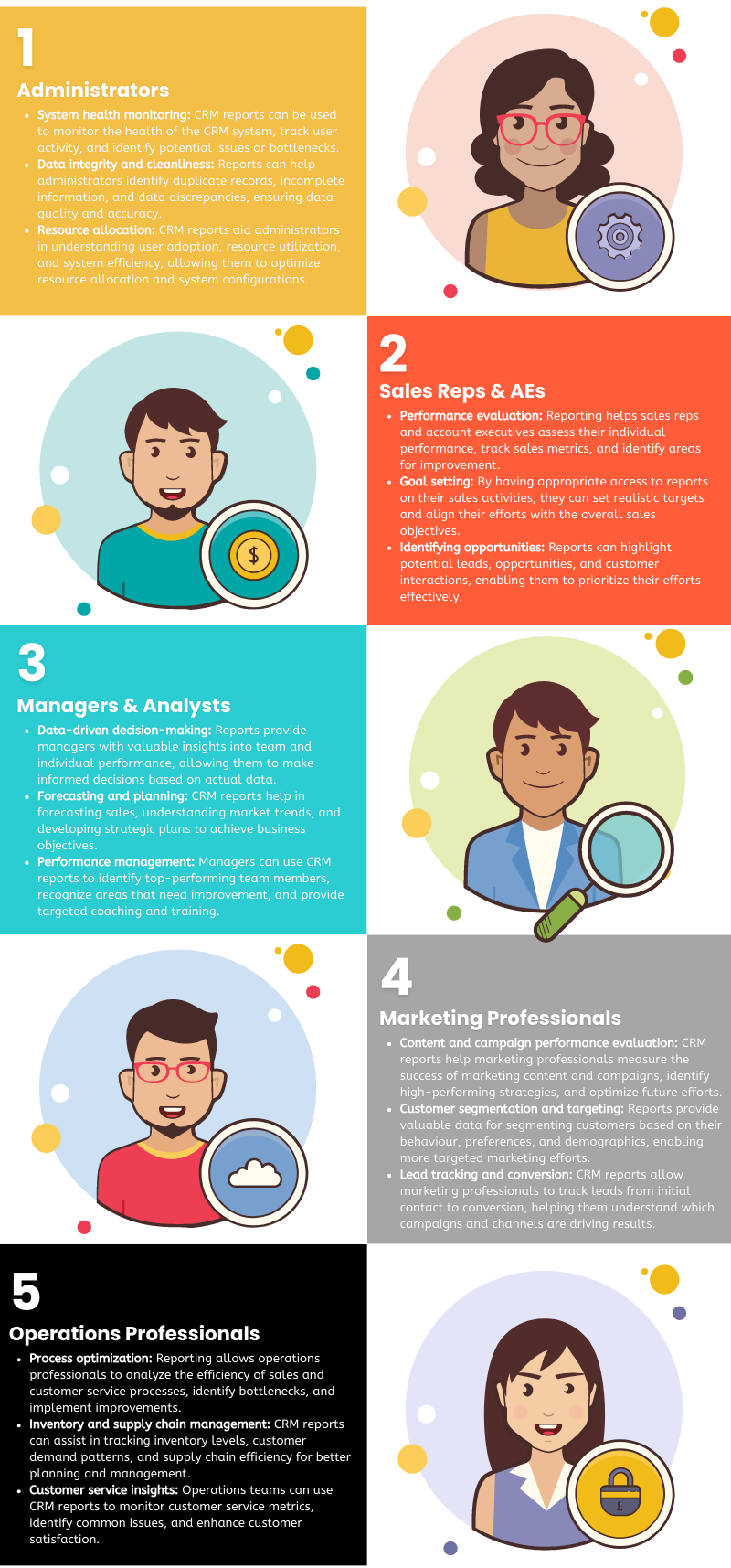While some business practices may differ among companies, there are common user roles or personas involved in the majority of CRM implementations. These personas typically represent different user types or job functions within an organization. Why would it be important to know them, and why do they matter?
To maximize the system’s potential, considering various use cases aligned with the different job functions among CRM users can be incredibly valuable. Drawing inspiration from UX, we embrace the concept of personas to craft an interface that addresses the distinct requirements of each user group through modifying different tools like screen flows, page layouts, data entry fields, and so many more. By doing so, you’re able to create a tailored and user-centric CRM experience that enhances efficiency and productivity for all users.
Understanding user personas is indispensable, whether you’re implementing a new CRM or undertaking a system clean-up. Customizing the CRM to enhance user experience and adoption, providing targeted training and support, ensuring data accuracy, and gaining valuable insights through reporting are just a few reasons why you’d want to consider who you are building for. By aligning the CRM system with the workflows and preferences of these different user types, this also empowers the company to scale and adapt the system effectively as it continues to grow and evolve. In this article, we lay out some major/common personas and what can be helpful to know when tailoring a CRM to meet their needs.

Administrators (Admins)
The CRM administrator is responsible for managing the configuration, customization, and overall administration of the platform. They handle tasks such as user management, security settings, data management, workflow automation, and system customization. Although a company may be working with an external implementation partner, sometimes there is also an admin or admins who are involved in the management of the CRM internally. Irrespective of whether admins are internal or external, their active involvement, allyship during the building phases, and insight into the technical aspects of the build design are usually crucial to ensure the proper labelling of process components and version notes for automations. Cohesion between stakeholders will also help with the enablement and future management/maintenance of the tool after the go-live date.
The Needs and Wants:
Building with administrators in mind:
User management, security settings (governance), data management, system customization
Providing easy-to-use admin interfaces, as well as comprehensive training and resources (documentation) will be advantageous when transferring responsibilities from one admin to another.
Sales Representatives & Account Executives
Sales professionals are a vital persona when building a company’s CRM system, such as Salesforce or HubSpot. They heavily rely on the CRM to efficiently manage their sales processes. Leveraging the CRM capabilities of let’s say Salesforce, they can track leads, manage contacts and accounts, create and manage opportunities, and closely monitor sales activities and performance metrics. However, having sales adopt the change can be the biggest challenge, as they can often be adverse to change. Nevertheless, it is crucial to prioritize this persona during CRM development to streamline their sales processes and enhance their overall productivity.
By understanding their specific needs and workflows, the CRM can be tailored to provide intuitive interfaces, seamless integration with sales tools, and mobile accessibility, enabling sales professionals to work more effectively and achieve their goals. When the sales team adopts the CRM effectively, it not only benefits them in prospecting and pipeline management but also significantly impacts downstream accurate forecasting that executive and board teams rely on to run the business. Therefore, ensuring smooth integration and encouraging sales to embrace the CRM becomes essential for the success of the entire organization.
The Needs and Wants:
Building with administrators in mind:
Lead routing and tracking, deduplications, contact and account management, opportunity management, clear layouts, optimal BDR handoff, easily accessible data, streamlined basic tasks (e.g., booking a meeting, creating an opportunity) for effortless execution with minimal click-throughs
Intuitive, user-friendly interfaces that display essential data without the need for scrolling through tabs, pages, etc., seamless integration with other sales tools, mobile accessibility (dependent on company), and a clear commission structure
Managers & Analysts
Managers utilize CRMs to oversee the sales team’s activities, analyze sales data, and make informed decisions. They gain insights from reports and dashboards, monitor pipeline progress, assign and track tasks, and provide guidance to their sales, service, or ops representatives. There will be no doubt that at the top of their wish lists will be effective sales team management and performance analysis.
The Needs and Wants:
Building with administrators in mind:
Sales data analysis, data cleanliness, pipeline tracking, task assignment, reporting
Advanced reporting and dashboard capabilities, task assignment and tracking features, real-time analytics
Marketers
Marketers may leverage certain parts of a CRM system to create, execute, and track marketing campaigns across various channels. They manage customer data, segment audiences, create personalized marketing content, automate marketing workflows, and track the performance of their marketing efforts. As well as managing campaigns, customer engagement is also an important part of the system to marketing professionals. Another part of the tool important to marketers is reporting, which you can read more on below. For marketing professionals, a key priority lies in connecting the dots through reporting. They must comprehend the impact of their X million marketing spend on the pipeline. CRM plays a pivotal role in measuring performance, providing valuable insights, and guiding strategic pivots.
The Needs and Wants:
Building with administrators in mind:
Audience segmentation, personalized content creation, marketing automation, sales engagement performance, insights
Marketing automation tools, audience segmentation capabilities, integration with marketing channels
Operations Professionals
The Operations professional persona is a vital consideration when building out a CRM due to several reasons. Operations professionals ensure efficient workflows, maintain data integrity, coordinate system interactions, and monitor operational performance. By involving them in CRM development, organizations can benefit from their insights to optimize business processes, establish data governance practices, enable seamless system integrations, and provide comprehensive reporting capabilities, and prepare for the future growth. Reporting is also of utmost importance to operations professionals as their input lays the foundation for generating quarterly reports and gaining valuable insights into performance across all aspects of the business. For this persona, seamless access to essential information is a top priority. They seek to avoid unnecessary complexities and value straightforward, user-friendly layout system designs and dashboards that offer valuable insights efficiently. Their involvement ensures that the CRM system aligns with operational goals, enhances efficiency, and supports the organization’s long-term operational objectives.
The Needs and Wants:
Building with administrators in mind:
Process optimization, data management, seamless system integrations, meaningful insights (reporting), easy access to essential information
Validation rules, optimal and appropriate governance, necessary information they’ll want visibility on (ie. system fields, metrics, etc.) – careful consideration to layout designs will be of utmost importance!
Reporting
If you noticed a common theme in the previous sections, it’s that we can’t stress enough the importance and advantages of CRM reporting. Reporting tools within CRM systems are crucial and can be a need and major want for various roles within an organization. So, if you have a CRM but haven’t started leveraging reporting tools yet, it’s high time to get on board! “How does that saying go again? ‘If you can’t measure it, you can’t improve it?'”
In a nutshell, CRM reporting empowers data-driven decisions, enhances performance management, improves customer understanding, and optimizes various business processes, making your teams more efficient and effective in reaching their goals. Here’s why reporting is essential for each of the personas we’ve already introduced above!…

Understanding the different user personas in a company’s CRM system is vital for successful implementation, adoption, utilization, and measuring for business success through reporting. It’s important to note that these personas can vary depending on the organization and its specific use case for a CRM. Different organizations may have additional or slightly different personas based on their unique needs and processes. By considering the unique needs and workflows of each persona, organizations can customize the CRM to enhance the user experience and adoption of tools, improve productivity, and provide targeted training and support for their teams. Additionally, focusing on data accuracy and scalability ensures the CRM system can adapt and grow as the company does! Whether it’s sales reps, managers, marketers, or ops professionals, taking into account their specific needs and preferences ensures a more efficient and effective CRM system and by investing the effort to understand and build with these user personas in mind, companies can truly maximize the value and potential of their CRM implementation.
